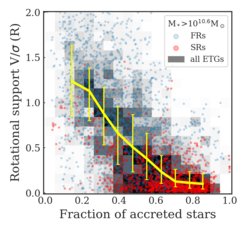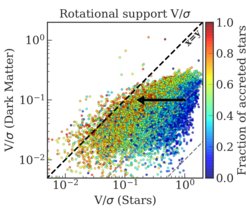The stellar halos of ETGs in the IllustrisTNG simulations: II. Accretion, merger history, and dark halo connection
Pulsoni, C., Gerhard, O., Arnaboldi, M., Pillepich, A., Rodrigeuz-Gomez, V., Nelson, D., Hernquist, L., Springel, V., 2021, A&A, 647, A95
Stellar halos of early type galaxies (ETGs) are found to display kinematic changes with radius that reflect changes in their intrinsic structure in both observations (Pulsoni et al. 2018) and simulations (Pulsoni et al. 2020). We analyse simulated ETGs from the IllustrisTNG cosmological simulation to investigate the relation between stellar halo structure and accretion history.
Changes in the dynamical structure of ETGs are related to mergers only in massive systems, while in low mass galaxies (with stellar mass < 10^10.6 Msun) the in-situ-born stars completely determine any kinematic and photometric variation. In massive ETGs, mergers modify the galaxy structure by suppressing rotation (Figure I) and contributing to more spherical-triaxial halo shape. In addition, mergers dynamically couple stars and dark matter so that, where the accreted stars dominate over the in-situ, stellar and dark matter components have similar rotational support and intrinsic shapes (Figure 2).
These correlations between halo structural properties and accreted fractions are followed by fast and slow rotators alike with a continuous and overlapping sequence of properties, but slow rotators have on average higher accreted fractions and are more dominated by dry major mergers.
Hence, the wide variety of kinematic and photometric properties observed in ETGs at large radii reflects their diverse evolution in a cosmological context.



